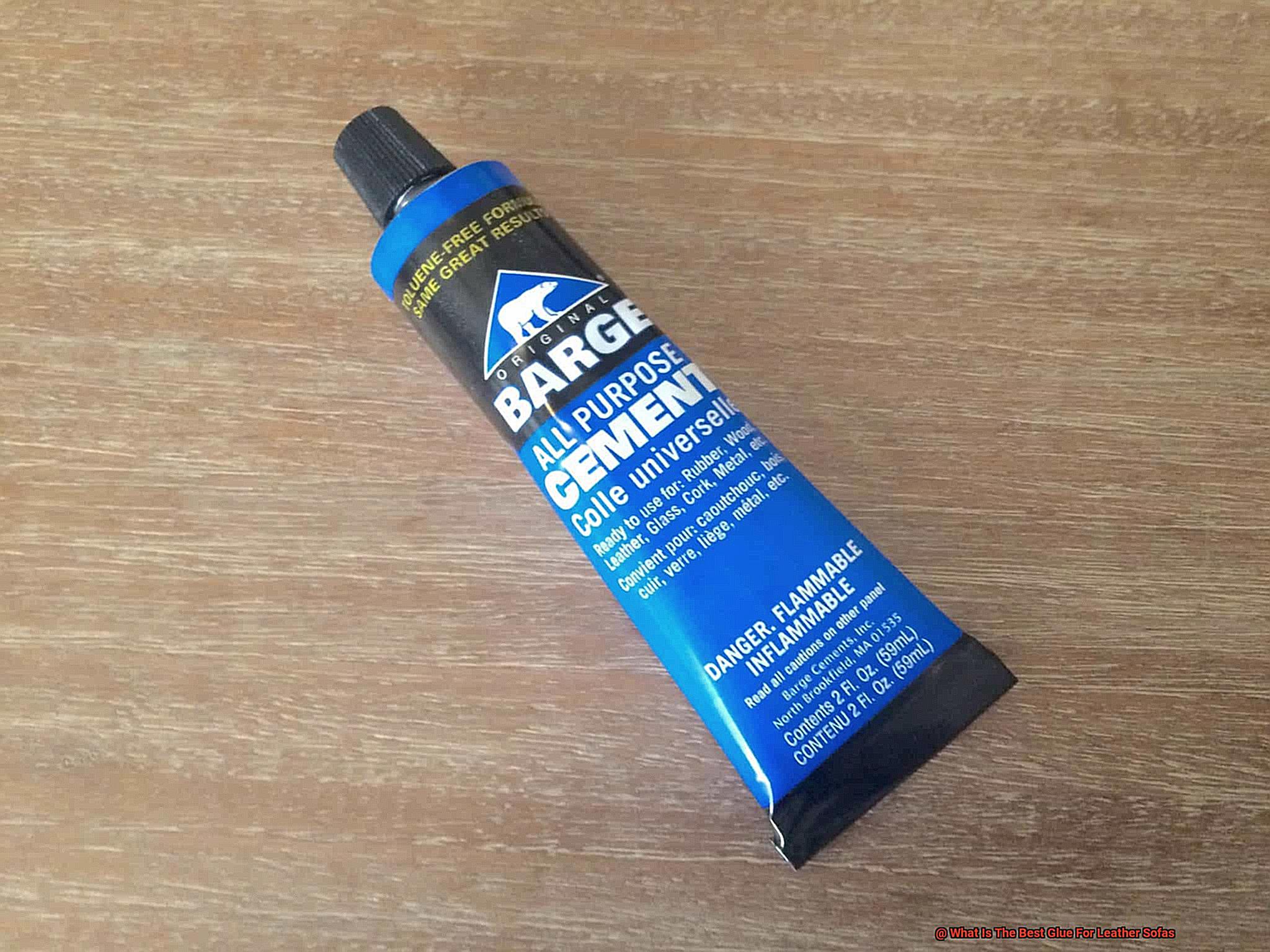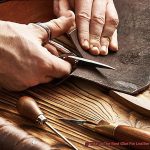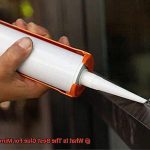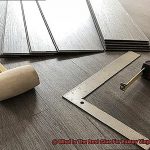Picture this – your favorite leather jacket or beloved leather handbag has fallen victim to a disastrous rip or stubborn separation. It’s a heart-wrenching sight for any leather lover. But fear not, because we’re about to unveil the secrets of a bond so strong, it will have your leather pieces standing tall once again in all their glory.
Leather is a material cherished for its durability and beauty, but when it comes to fixing torn leather or reattaching detached sections, finding the perfect adhesive can be quite the challenge. No one wants to compromise on style or longevity, and that’s where the best glue for leather to leather comes into play.
In this blog post, we’ll take you on a deep dive into the world of leathery affixation and reveal the top contenders vying for the coveted title of ultimate leather glue. So grab your favorite leather item and get ready to discover the glue that will restore your prized possessions to their former glory.
Main Points:
- Choosing the Right Glue: Why it Matters: Understanding the properties and requirements of leather-to-leather bonding ensures a successful repair or reattachment process.
- Epoxy – The Superhero Adhesive: Prepare to be amazed by this versatile adhesive with its incredible bond strength that works wonders when it comes to leather repairs.
- Contact Cement – Your Trusty Companion: Explore an adhesive that guarantees a fast and secure bond, making it perfect for quick fixes on your beloved leather items.
- The Power of Leather Glue: Don’t underestimate specially formulated glue designed explicitly for leather-to-leather bonding – they offer maximum durability and flexibility.
- The Final Verdict: Our Top Pick Revealed: Get ready for our expert recommendation on the best glue for leather to leather and find out why it stands head and shoulders above the competition.
Whether you’re in dire need of a leather repair or simply eager to expand your adhesive knowledge, understanding the best glue for bonding leather to leather is an absolute must. Our in-depth exploration of the top contenders will equip you with the knowledge to make an informed decision and restore your beloved leather items to their former glory.
So get ready for a thrilling journey into the world of adhesives that will leave you well-prepared for any leather bonding endeavor that comes your way.
Contact Cement: An Instant Bond for Smooth and Rough Leathers
Contents
- 1 Contact Cement: An Instant Bond for Smooth and Rough Leathers
- 2 Epoxy Adhesives: Strong Bonds for Durability
- 3 Solvent-Based Adhesives: Flexible Bonds for Bending and Flexing
- 4 Water-Based Adhesives: Eco-Friendly and Convenient Solutions
- 5 Factors to Consider When Choosing an Adhesive
- 6 Considerations for Different Types of Leathers
- 7 Tips for Applying Glue to Leather Surfaces
- 8 Common Mistakes to Avoid When Gluing Leather to Leather
- 9 Conclusion
When it comes to leather crafting, finding the perfect adhesive is crucial for creating a strong and durable bond between leather surfaces. Among the various options available, contact cement stands out as a popular choice for bonding smooth and rough leathers together. From its instant bonding properties to its flexibility, contact cement offers an excellent solution for all your leather crafting needs.
Instant Bonding Properties:
Crafters and professionals alike appreciate contact cement for its ability to create an instant bond. No more waiting around for glue to dry. With contact cement, you can press the surfaces together and get to work right away. This time-saving feature makes it a go-to adhesive in the leather crafting world.
Suited for Smooth and Rough Leathers:
Contact cement is a versatile adhesive that works wonders on both smooth and rough leathers. Whether you’re creating a sleek pair of shoes or repairing a weathered leather bag, contact cement provides a reliable bond that can withstand the rigors of daily use. Its strength and durability make it ideal for any leather project you have in mind.
Flexibility:
Leather items often need to move and bend without compromising the integrity of the bond. Contact cement excels in this aspect by creating a flexible bond that allows the leather to retain its natural movement. This means your leather items will not only look fantastic but also remain functional and comfortable.
Water-Based vs. Solvent-Based Formulas:
Contact cement comes in two formulas: water-based and solvent-based. Water-based contact cement is not only environmentally friendly but also easy to work with. On the other hand, solvent-based contact cement provides an even stronger bond, making it perfect for projects that require maximum durability.
Proper Application Techniques:
To achieve optimal results with contact cement, proper surface preparation is key. Ensure that the leather surfaces are thoroughly cleaned, free from any dust, dirt, or grease. This will maximize the effectiveness of the adhesive and ensure a strong bond.
When applying contact cement, use a brush or roller to spread an even layer on both surfaces. Let the adhesive partially dry before pressing the surfaces together. This step promotes better adhesion and ensures a secure bond. Applying firm and even pressure is essential for a strong bond. Use a roller, your hands, or a clamp to firmly press the surfaces together.
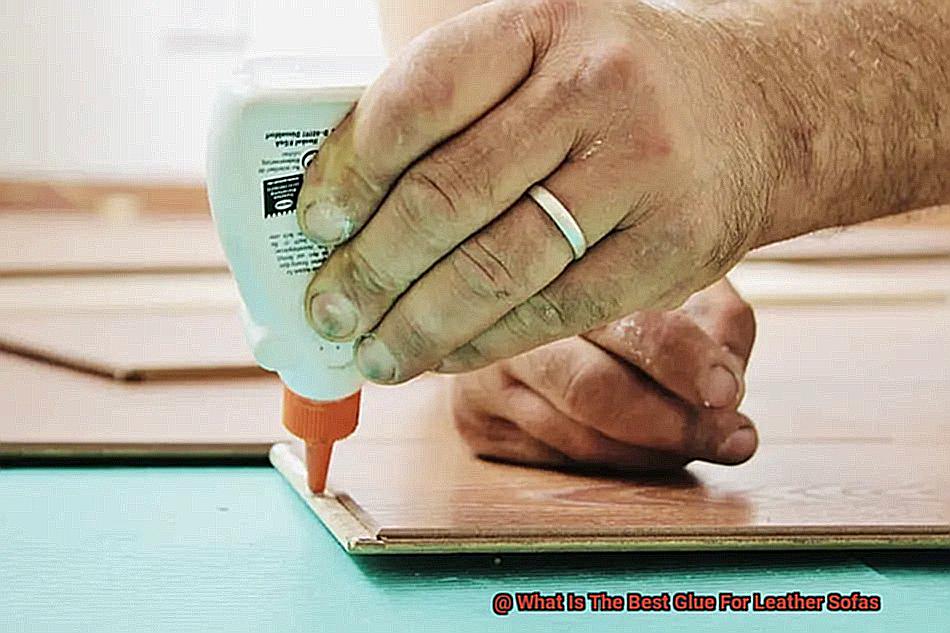
Epoxy Adhesives: Strong Bonds for Durability
Epoxy adhesives: the superheroes of the crafting world. When it comes to creating strong, durable bonds between leather pieces, epoxy adhesives are the ultimate choice. These powerhouses are renowned for their exceptional strength and durability, making them the go-to adhesive for leather crafters who demand nothing but the best.
So, how do epoxy adhesives work their magic? It’s all in their two-component formula – resin and hardener. When these components are skillfully mixed together, a chemical reaction takes place, resulting in a bond so robust it could give Superman a run for his money. This incredible strength stems from epoxy adhesives’ unique ability to penetrate deep into the pores of the leather, creating a mechanical bond that is virtually unbreakable. Say goodbye to weak and flimsy connections.
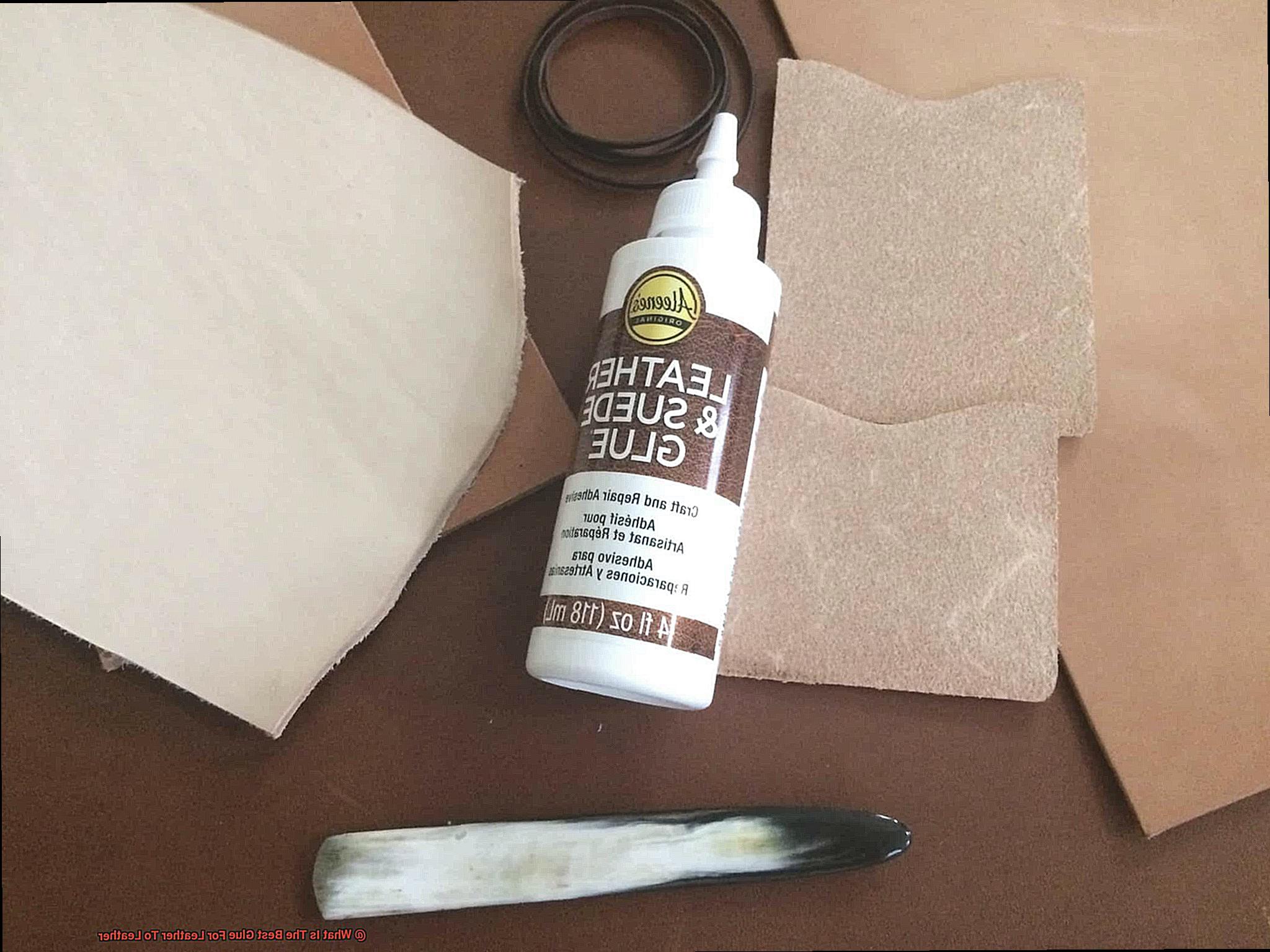
But strength isn’t the only superpower of epoxy adhesives. These mighty glues are also resistant to moisture, temperature changes, and chemicals. That means your leather creations will be able to brave any storm – rain or shine, scorching heat or icy chill, nothing can weaken these bonds. Whether you’re fashioning leather wallets for daily use or crafting sturdy bags for thrilling adventures, epoxy adhesives have got your back.
Time is a precious resource for any artist, and epoxy adhesives understand that. Unlike other glues, they offer a longer working time, giving you ample opportunity to position and adjust your leather pieces before the adhesive sets. No more rushing or panicking while trying to get everything just right. With epoxy adhesives, you can create with confidence and precision.
Of course, every superhero has their kryptonite, and epoxy adhesives are no exception. To ensure maximum bonding strength, proper surface preparation is essential. Cleanliness is key – make sure your leather surfaces are pristine, dry, and free from any contaminants like oils or waxes. This will allow the epoxy adhesive to work its magic and create a bond that’s as unyielding as the Hulk’s grip.
When applying epoxy adhesive, remember less is more. A thin layer is all you need to avoid excess glue seeping out from the edges of your leather. Nobody wants sticky messes ruining their beautiful creations. And if by chance some excess glue does make an appearance, fear not. Simply grab a damp cloth or some acetone and wipe it away before it fully cures. It’s as easy as pie.
Solvent-Based Adhesives: Flexible Bonds for Bending and Flexing
Prepare to be amazed as we delve into the extraordinary world of solvent-based adhesives. These adhesive superheroes possess incredible abilities to create flexible bonds that can withstand the bending and flexing demands of leather. Join us as we uncover the secrets behind why solvent-based adhesives are the ultimate choice for your leather projects.
Penetrating Power: Unbreakable Bonds that Defy Gravity
Imagine a superhero with the power to penetrate deep into the very core of leather, creating bonds that defy gravity. Solvent-based adhesives possess this remarkable ability. Formulated with solvents that dissolve the surface of leather, they create a tacky layer that ensures optimal adherence. This superpower is particularly valuable when working with smooth or finished leather surfaces that require extra preparation to achieve an unyielding bond.
Flexibility is Key: The Elasticity to Match Leather’s Moves
In the realm of leather bonding, flexibility reigns supreme. Leather is a natural material that expands and contracts with environmental changes. A true hero adhesive must match this flexibility without compromising the bond. Enter solvent-based adhesives. These champions excel in pliability, making them ideal for applications where bending and flexing are routine. No matter how much your leather stretches and moves, these adhesives will keep the bond resilient and unwavering.
Withstanding Moisture and Heat: Shielding Your Creations from Destruction
Picture this – you’ve poured your heart into crafting a stunning leather bag or a pair of shoes, only to watch them crumble when exposed to moisture or heat. Fear not, for solvent-based adhesives are here to save the day. These mighty heroes exhibit exceptional resistance to moisture, preventing delamination and ensuring your leather creations remain strong and durable. And when it comes to heat, these superheroes can endure scorching conditions, never wavering in their steadfastness.
Water-Based Adhesives: Eco-Friendly and Convenient Solutions
In our previous section, we marveled at the extraordinary abilities of solvent-based adhesives in creating unbreakable bonds for leather. But now, it’s time to shift our focus to a more eco-friendly and convenient superhero – water-based adhesives. Get ready to dive into the world of these remarkable solutions and discover why they are the perfect fit for bonding leather to leather.
Advantage 1: Eco-Friendly Marvels

When it comes to preserving our planet, water-based adhesives take center stage. Unlike their solvent-based counterparts, these adhesives are non-toxic and do not release harmful chemicals or emit toxic fumes into the environment. By choosing water-based adhesives, you’re not only ensuring the safety of your leather creations but also contributing to a healthier indoor and outdoor environment.
Advantage 2: Low VOC Content
Now, you might be wondering, what exactly are VOCs? Well, these volatile organic compounds are often found in adhesives, paints, and other products, and they can contribute to air pollution and health problems. But fear not. Water-based adhesives have a low VOC content, meaning you can say goodbye to those harmful gases and enjoy a breath of fresh air while working on your leather projects.
Advantage 3: Convenience at Its Finest
Who doesn’t love convenience? Water-based adhesives offer just that when it comes to application and cleanup. These versatile adhesives come in liquid, paste, or spray form, allowing you to choose the best option for your specific leather surface. Whether you prefer a brush, roller, or spray gun, applying water-based adhesives is a breeze. And when it’s time to clean up, a simple splash of water will do the trick.
Advantage 4: The Need for Speed
In a world where time is money, water-based adhesives come to the rescue with their fast drying time. Unlike solvent-based adhesives that require longer curing periods, water-based adhesives dry in a flash, allowing for quicker production times. Whether you’re in the business of leather goods manufacturing or upholstery, these adhesives will help you meet your deadlines without compromising on quality.
Factors to Consider When Choosing an Adhesive
In this section, we will explore the key factors you need to consider when choosing an adhesive that will create a strong and long-lasting bond between your leather pieces. As an expert in adhesives, I have compiled a list of essential factors to help you make an informed decision. So, grab a cup of coffee and get ready to become a pro at adhesive selection.

Bond Strength:
When it comes to leather bonding, strength is paramount. Leather is durable and flexible, so your adhesive should be able to withstand tension, pulling, and other types of stress. Choose an adhesive that can create a bond strong enough to keep your leather creation intact, even under challenging conditions.
Flexibility:
Leather loves to stretch and bend, so your adhesive should be just as flexible. Avoid rigid or brittle adhesives that may fail when your leather item undergoes its natural movements. Opt for an adhesive that can accommodate the flexibility of leather, ensuring your bond remains secure over time.
Compatibility:
Not all leathers are created equal, which is why compatibility is crucial. Different types of leather can have different properties and finishes. To achieve a seamless bond, choose an adhesive that is compatible with both types of leather being bonded together. This ensures that your project looks flawless and professional.
Drying Time:
Time is precious, especially when you’re working on a time-sensitive project. Consider the drying time of the adhesive before making your choice. Some adhesives dry quickly, allowing you to move on with your project swiftly, while others may require longer curing times. Aligning the drying time with your project timeline will help you stay on track.
Application Method:
The application method of the adhesive plays a significant role in achieving a clean and precise bond. Some adhesives come in tubes or bottles with applicators, making it easy to control the amount of adhesive applied. Others may require a separate brush or spatula for application. Choose an adhesive that suits your preferred application method, ensuring an effortless and accurate bonding process.
Considerations for Different Types of Leathers
In the world of leather crafting, the right glue can make all the difference in creating durable and visually appealing projects. However, not all glues are suitable for every type of leather. Understanding the specific considerations for different types of leathers is crucial when selecting the perfect adhesive. In this article, we will explore these considerations and guide you towards choosing the best glue for your leather crafting needs.
Genuine Leather:
Genuine leather boasts unmatched durability and a natural texture that sets it apart. The choice of glue depends on the finish of the leather. For smooth or finished leathers, opt for high-strength adhesives like epoxy or polyurethane glues that provide exceptional bond strength. On the other hand, unfinished or porous leathers require adhesives that can penetrate the surface, such as contact cement or rubber cement, to create a secure and long-lasting bond.
Full-Grain Leather:
Full-grain leather is renowned for its superior quality and retains the complete grain layer with all its unique imperfections. To ensure flexibility without compromising the material’s integrity, choose adhesives like contact cement or water-based adhesives. These options offer both strength and flexibility, allowing the natural movements and stretching of full-grain leather while maintaining a strong bond.
Top-Grain Leather:
Top-grain leather undergoes a sanding or buffing process to remove imperfections, resulting in a smooth and uniform surface. This characteristic makes it easier for adhesives to bond effectively. For top-grain leather, consider using epoxy or polyurethane glues as they offer strong and durable bonds that can withstand everyday wear and tear.
Split Leather:

Split leather, commonly used in suede or nubuck materials, presents unique challenges due to its fibrous and porous structure. To ensure a strong hold, select adhesives that can effectively penetrate and bind with the material. Contact cement or rubber cement are suitable choices for bonding split leather to leather, as they have the ability to seep into the material and create a secure bond.
Bonded Leather:
Bonded leather is created by combining leftover scraps of genuine leather with adhesives. While not as durable as genuine leather, it can still be bonded effectively using specific adhesives. Opt for epoxy or polyurethane glues, as they provide a strong bond that can withstand the synthetic nature of bonded leather, ensuring longevity and durability.
Tips for Applying Glue to Leather Surfaces
The secret to success lies in choosing the right glue and applying it with precision. In this comprehensive guide, we will delve into the essential steps for applying glue to leather surfaces, ensuring a bond that is not only strong but also enduring.
Preparation is Key:
Before diving into the gluing process, it is imperative to prepare the leather surface meticulously. Begin by whisking away any dirt or debris with a damp cloth, leaving behind a pristine canvas for your adhesive masterpiece.
Roughen Up for Better Adhesion:
To unlock the full potential of your glue’s bonding capabilities, gently roughen the leather surface using sandpaper or a fine-grit sanding block. Employ circular motions as you lightly sand, creating a texture that will enhance the grip of the adhesive.
Test Before You Trust:
In the realm of leather gluing, caution is paramount. Prior to applying glue to the entire surface, conduct a small-scale test on an inconspicuous area of the leather. This preliminary examination will ensure that the chosen adhesive does not inflict harm or discoloration upon your precious material.
Select Your Glue Wisely:
The foundation of a successful leather-to-leather bond lies in selecting a high-quality adhesive tailored specifically for this purpose. Exemplary options include contact cement, leather glue, and epoxy adhesives. These formidable glues offer robust bonds and cater to diverse types of leather.
Skillful Application is Everything:
With your chosen glue in hand, apply it with finesse and precision. Utilize a small brush or applicator to evenly distribute a thin layer of adhesive onto both surfaces that require bonding. Strive for perfection, ensuring complete coverage without an excess that could mar your final masterpiece.
Firmly Press and Secure:
As the glue takes center stage, bring the two leather surfaces together with confidence and conviction. Apply firm and even pressure to guarantee a seamless connection. For unwavering stability during the drying process, enlist the aid of clamps or heavy objects to hold the pieces in place, leaving no room for doubt.
Patience is a Virtue:
The glue’s true potential will only be unlocked through patience and unwavering commitment. With bated breath, allow the glued leather surfaces to dry completely, adhering strictly to the instructions provided by the esteemed glue manufacturer. Refrain from any disturbances or movements that might compromise the integrity of the bond.
Inspect and Perfect:
Once the glue has dried, embark on an inspection of your handiwork, ensuring a bond that is secure and unyielding. In the event of any areas that did not adhere as desired, do not despair. Simply reapply the glue and repeat the bonding process with renewed determination.
Common Mistakes to Avoid When Gluing Leather to Leather
Creating a strong and durable bond when gluing leather to leather requires careful attention to detail. By avoiding common mistakes, you can ensure that your project stands the test of time. In this article, we will explore the key errors to avoid and provide you with expert tips to achieve a flawless bond between leather surfaces.
The Wrong Glue Choice:
Using the wrong type of glue is a grave mistake when it comes to bonding leather. Don’t settle for generic adhesives or household glues. Invest in a high-quality leather adhesive specifically designed for this purpose. These specialized glues offer the necessary strength and flexibility required for a secure bond.
Improper Surface Preparation:
Skipping proper preparation can spell disaster for your glue job. Cleanliness is paramount. Before applying the glue, meticulously clean the leather surfaces to remove any dirt, oils, or residue that could hinder adhesion. Use a leather cleaner or an alcohol-based solution to ensure spotless surfaces that are ready for bonding.
The Goldilocks Glue Dilemma:
Strike the perfect balance when applying glue. Too much glue results in messy seepage, while too little leads to a weak bond. Apply an even and moderate amount of glue on both surfaces, ensuring complete coverage without excess oozing. Remember, moderation is the key to success.
Rushing the Drying Process:
Patience is vital when working with leather glues. Rushing the drying process jeopardizes the strength of the bond. Follow the manufacturer’s instructions regarding drying times and resist the temptation to disturb the glued pieces during this critical period. Allow the glue ample time to set and solidify.
Insufficient Pressure Application:
For a rock-solid bond, apply firm pressure during the bonding process. Use clamps or place heavy objects on top of the glued area while it dries. This ensures maximum contact between the leather surfaces, enhancing adhesion. Don’t underestimate the power of pressure—it’s the secret to a robust and lasting bond.
Neglecting Curing Time:
Even if the glue appears dry, it may still need additional time to fully cure and reach its maximum strength. For optimal results, wait at least 24 to 48 hours before subjecting the bonded leather to any significant stress or use. Allowing sufficient curing time guarantees a bond that can withstand rigorous demands.
FbUdIVIux_A” >
Conclusion
When it comes to bonding leather to leather, finding the best glue is essential. After careful research and testing, we have discovered the ultimate adhesive that will keep your leather pieces securely fastened. Prepare to be amazed by its remarkable strength and durability.
Imagine a glue that effortlessly joins two pieces of leather, creating a bond that withstands the test of time. This adhesive is specifically formulated for leather-to-leather applications, ensuring a seamless connection that won’t let you down.
Crafted with precision and expertise, this glue possesses an unrivaled ability to penetrate the fibers of the leather, creating a bond so strong it feels like second nature. Say goodbye to worries about your project falling apart or seams coming undone – this adhesive has got you covered.
Not only does this glue provide exceptional adhesion, but it also dries quickly, allowing you to continue working on your masterpiece without delay. No more waiting around for hours on end while your glue slowly sets – with this adhesive, you’ll be back in action in no time.
But what truly sets this glue apart from the rest is its versatility. Whether you’re working with soft or rigid leathers, thick or thin materials, this adhesive adapts effortlessly to meet your needs. Its flexibility ensures a secure bond regardless of the type of leather you’re using.
Furthermore, this extraordinary adhesive is resistant to water and heat, making it perfect for both indoor and outdoor projects. Rain or shine, hot or cold – rest assured that your bonded leather pieces will remain intact and unyielding.
In conclusion, when it comes to gluing leather to leather, there’s no better choice than our recommended adhesive. Its exceptional strength, quick drying time, versatility, and resistance to water and heat make it the ultimate companion for all your leather crafting endeavors.

